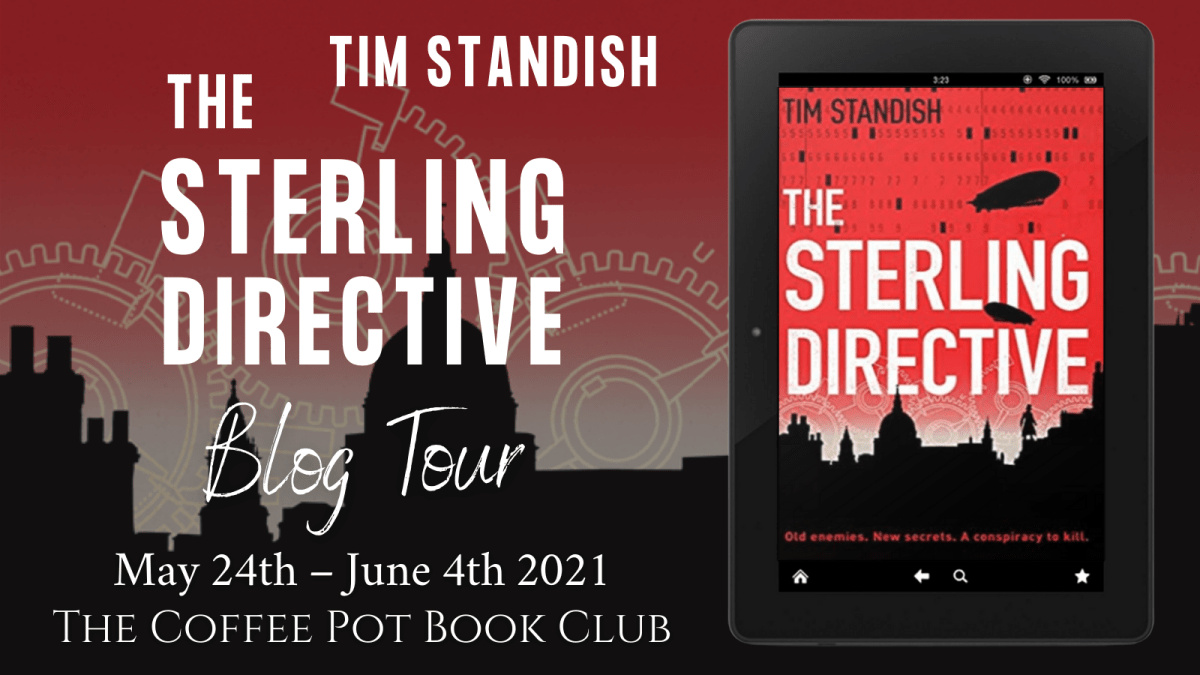Today I’m delighted to welcome Tim Standish to the blog with a fascinating post about his alternative historical fiction novel, The Sterling Directive.
Weaving with history: developing an alternative Victorian world for The Sterling Directive
A question that I get asked a lot by people when they first read The Sterling Directive is why write an alternative-history rather than a straight history novel? The simple answer is that it’s a genre that has always interested me. I loved the ‘Future Shock’ stories in the comic 2000AD that I read growing up and novels like Fatherland by Robert Harris as well as counterfactual exploration of the more serious kind, for example in the excellent ‘What if?’ series of historical essays.
The first inkling I had of The Sterling Directive, and long before I even knew I was writing a novel, was an idea for a scene of two men duelling on a late Victorian station platform. By then I had come across, and was greatly enjoying, the burgeoning genre of steampunk – its blend of geeky scifi and Victorian society really struck a chord with me and infused this scene from the beginning.
Several years later, when I began to write in earnest, I was consciously sitting down to write an alt-historical novel of the kind that I would enjoy reading – probably a thriller, definitely story-led and in a world that was a recognisable alternative not too far from our own world.
I wanted to create an alternative history that that supported the story rather than driving the story, one that was alternative but alternative ‘in the background’, as part of a believable world that had evolved organically away from actual history. The science fiction writer William Gibson was a big influence on this choice, as he does a great job of revealing a dystopian future as a world that seems as natural to me as a reader as it does to the characters within it, for example in his novels Count Zero or Virtual Light.
I had read enough Victorian-set fiction, as well as works in the expanding alt-Victorian genre, to have a broad sense of the setting. However, while existing knowledge was enough to get me started, I realised pretty quickly that there would be an ongoing list of research questions large and small that I would need to answer along the way. These ranged from the micro ‘what would an evening gown look like in 1896’ to the macro ‘How might the Confederate States have won the American Civil War?’.
For very specific questions my first port of call was the internet. Given the wider fascination with the Victorian and Edwardian eras, I soon discovered there is a wealth of information to be found on sites ranging from personal blogs to academic research centres. The online catalogues of museums and auction galleries were also a boon when it came to furniture, and other odds and ends for set dressing. From time to time my searching for one thing accidentally led me to something else – the Stirn Waistcoat Camera was one such item that provided a helpful boost to a particular aspect of the plot.
Social media is also a superb resource for this sort of thing, for example @WikiVictorian on Twitter and @millywdresshistorian on Instagram whose eclectically curated photos are a great source of creative sparks.
The broader questions that needed answering inevitably involved some more in-depth research.
In The Sterling Directive’s world Babbage’s Difference Engine has given rise to a late Victorian computer age. This is a familiar theme in alt-Victorian fiction, though one that I wanted to firmly root in reality. Tom Standage’s The Victorian Internet, exploring the early use of the telegraph and drawing similes to the early internet provided an excellent starting point and something that I returned to time and again. Another is Electronic Brains: Stories from the Dawn of the Computer Age by Mike Hally. Kevin Mitnick’s books describing his experiences as a hacker in the early days of computing were also a great source of anecdotes and personalities.
In terms of the people and politics of Victorian society, I started with Lytton Strachey’s Eminent Victorians and read out from there. I also went to a Victorian History symposium at the V&A and the associated book, The Victorian Visionprovided another good jumping off point. Donald Thomas’ The Victorian Underworld was another, as was Henry Mayhew’s London Labour and the London Poor.
Probably because it has always interested me, and because it is the centre of the protagonist’s world in The Sterling Directive, I did quite a lot of reading into the early days of espionage. Christopher Andrew’s histories of MI6 and MI5 were early influences, particularly the descriptions of the Topographical and Statistical Department which inspired shady off-book agency The Map Room and their governmental antagonists The Bureau of Engine Security in The Sterling Directive. Michael Smith’s The Spying Game was another key source as was John Hughues-Wilson’s The Puppet Masters, a world history of spying.

Finally, one key source for everything and anything was my brother. Far more widely read than myself, and with a background in antiquarian books, his encyclopaedic knowledge was invaluable at various stages, from pointing out that a song a character was singing hadn’t been written yet, to recommending books.
Hopefully that gives you a sense of where the historical aspects of The Sterling Directive came from, but what about the ‘alternative’ part? Having already decided that I wanted something less divergent and fantastical, it struck me that it would be helpful to set a broad frame and to have some rules of thumb in place.
In terms of a frame, I used Charles Babbage’s invention of the Difference and Analytical Engines as a point of divergence; in my timeline the Engines were actually a success and kick-started a Victorian computer age. It’s a relatively common notion in ‘steampunk’ fiction which can lead to wildly differing and often fantastical versions of history.
I wanted to plot a more organic evolution from this starting point. My first bit of reasoning was that the development of Babbage’s Engines would lead to domestic computers for richer households by 1896 (when The Sterling Directive is set). I saw this as broadly analogous to the time elapsed between the use of the Bletchley Park ‘bombes’ in the second world war and the spread of basic personal computers at home in the mid to late 1980s and early 90s. That time period became my overall benchmark for computing technology and its likely impact on a Victorian world.
Using this as a broad frame I also developed some principles or rules of thumb to judge alternative ideas ‘out’ or ‘in’:
- Access to computing power means calculations and hence research can be accelerated and that new technologies can emerge 15-20 years early. For example: airships are commonplace.
- Inventions and ideas that existed but at the fringe can become more mainstream. For example: a mechanised version of Bertillon’s measurement system is the default means of identifying people.
- Wider use of technology will have a destabilising impact on broader societal norms. For example: Suffragettes are an active lobbying group in the 1890s.
- Rules are breakable if doing so a) serves the plot or b) is cool. For example: transport devices used in Chapter 20, details of which would be a spoiler!
Some of the changes I introduced were based on outliers from real history, or by introducing them earlier than in reality. For instance, I decided that Brunel’s wide-gauge railways were a commercial and UK-wide success (and, crucially for one scene, allowed the heroes to have a game of billiards as they travelled).
Some changes were a product of transposing an approximation of the 1980s into an approximation of the 1890s and were often in the background. One of my favourites was based on the Hard Rock café style of themed restaurants that I remember being quite the thing in the 1980s. I wondered what a Victorian version of this would be like and had the idea of a Dickens-themed chain of restaurants called ‘Pickwicks’, that I imagined would be festooned in memorabilia and merchandise and perfect for a low-key lunch in an airport.
Finally, some changes were a result of the sorts of questions posed by historians in the What-if? series of books. The biggest one of these in The Sterling Directive is ‘What if the Confederates won the Civil War?’ shortly followed by ‘How would that happen?’ and ‘What would that mean for the rest of the world?’. It is a big question that I only begin to answer in The Sterling Directive. It’s one that I’ll continue to tackle as the series progresses, starting with the second book which takes place in The Confederate States of America in 1898. A shelf or two of reading awaits…
Thank you so much for sharing your research and reasoning. It sounds fascinating – playing with ‘history’ in such a way.
Here’s the blurb:
It is 1896. In an alternative history where Babbage’s difference engines have become commonplace, Captain Charles Maddox, wrongly convicted of a murder and newly arrested for treason, is rescued from execution by a covert agency called the Map Room.
Maddox is given the choice of taking his chances with the authorities or joining the Map Room as an agent and helping them uncover a possible conspiracy surrounding the 1888 Ripper murders. Seeing little choice, Maddox accepts the offer and joins the team of fellow agents Church and Green. With help from the Map Room team, Maddox (now Agent Sterling) and Church investigate the Ripper murders and uncover a closely guarded conspiracy deep within the British Government. Success depends on the two of them quickly forging a successful partnership as agents and following the trail wherever, and to whomever, it leads.
An espionage thriller set in an alternative late 19th-century London.
Amazon UK: Amazon US: Amazon CA: Amazon AU:
Barnes and Noble: Waterstones: Audio:
Meet the Author
Tim Standish grew up in England, Scotland and Egypt. Following a degree in Psychology, his career has included teaching English in Spain, working as a researcher on an early computer games project, and working with groups and individuals on business planning, teamworking and personal development.
He has travelled extensively throughout his life and has always valued the importance of a good book to get through long flights and long waits in airports. With a personal preference for historical and science fiction as well as the occasional thriller, he had an idea for a book that would blend all three and The Sterling Directive was created.
When not working or writing, Tim enjoys long walks under big skies and is never one to pass up a jaunt across a field in search of an obscure historic site. He has recently discovered the more-exciting-than-you-would-think world of overly-complicated board games.
Connect with the author.
Author image taken by Hannah Couzens Photography.




